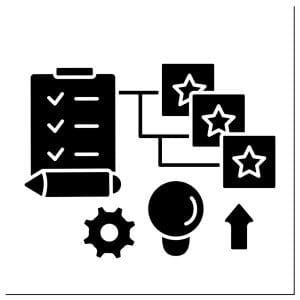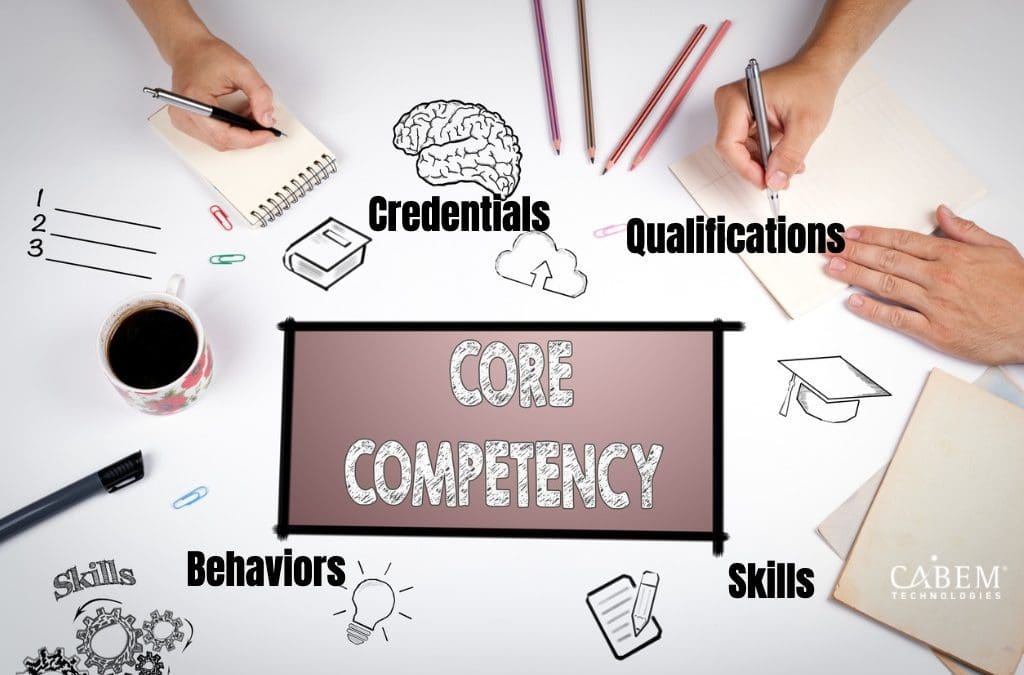3 Critical Components of Your Competency Management
Organizations are tasked with the challenge of retaining highly skilled employees in a rapidly growing and competitive market. They seek to improve performance and develop leaders within their business. Competency Management helps leaders determine what behaviors, credentials (or qualifications), and skills are necessary for the organization to grow and succeed in the future. In this blog we will take a closer look at three important components in competency management: behaviors, credentials (or qualifications), and skills.
Competency Management is a formal organizational approach that defines the skills, knowledge, and behaviors needed in a business. According to Investopedia, core competencies are defined as “strategic advantages of a business, including the combination of pooled knowledge and technical capacities, that allow it to be competitive in the marketplace.” Competency-driven organizations are able to determine exactly where employees shine and who they need to recruit. They feel confident that their workers are proudly mastering and developing their talents, and most of all, it is clear that the entire organization is working together to achieve its’ goals.
Competency Management in an organization requires understanding and clear communication of the values and skills that are needed to succeed in a particular role. In a rapidly growing and competitive market, competency management allows employees to stay productive, master vital job-related skills, and have a clear understanding of what is expected of them. A strong culture of competency management adds to the value of any company because it works seamlessly to develop leaders and improve performance at all levels of an organization.
Behaviors Are A Crucial Component of Competency Management

Soft skills are an important part of competency management
What are behavioral competencies?
A behavioral competency is any behavior, attitude, or personality trait that is critical to success in a specific role in an organization. It is an observable behavior that proves an employee, or potential employee, possesses a particular competency. Being skilled with the technical aspects of a job can only take an employee so far.
Also known as soft skills, these behavioral competencies are needed for people to prosper and grow in the workplace. Some examples of these soft skills are collaboration, critical thinking, perseverance, patience, and communication. These skills can be taught. Some soft skills are innate and come naturally, but others can be practiced and honed over time. Companies that invest time to enhance soft skills and technical skills with their employees will grow and reap the rewards. Soft skills can weaken if they go unused so it is important to practice them continuously. Sometimes employees simply lack the experience with soft skills and with practice, they could develop into highly effective and productive employees.
There are some behavior competencies that are universal and can indicate success in any position within an industry. Qualities such as dependability, hardworking, and motivation are needed for success in any organization. However, depending on the nature of the job, different soft skills are prioritized over others. Looking at the specific role within an organization can help narrow down the behavior competencies most valued for that position. This helps reduce both time and resources when hiring new employees and overall will ensure that employees develop and improve their productivity. Soft skills capture the general values, guiding principles, and leadership priorities of the organization.
What are some soft skills that organizations are seeking in their employees?
Leadership is the soft skill that ranks number one on any list as the most desirable soft skill. Organizations need strong leaders that are able to inspire and motivate other individuals to succeed and work at a high level. A person with leadership skills is inspirational, encouraging, and empathetic to other employees. When an organization has an effective leader, employee turnover is eliminated, productivity shoots up and employees are happy. Leaders are authentic, flexible, motivating, and trustworthy.
Teamwork and Collaboration are behavioral competencies that go hand in hand. For an organization to function effectively, people must work well together to achieve a common goal. The quality of work improves when people use their strengths and skills together collaboratively. It is important for employees to interact respectfully and productively. Tasks must be able to be completed quickly and efficiently. In order for a business to progress and grow, all employees must bond with each other and move as one unit – like a well-oiled machine. Team players are intuitive, empathetic, and interpersonal.
Possessing strong verbal and non-verbal communication skills to effectively speak with team members is crucial. This skill helps you interact effectively with all of the people you encounter. Communication is important in many aspects of a job, whether it be public speaking, communicating ideas to team members, or keeping a positive attitude. Without strong communication skills, many other soft skills would be rendered useless. Effective communicators are active listeners, assertive, and patient.
Problem Solving is a critical behavior in most organizations. People that can handle stress, prioritize tasks, and fix problems are extremely valuable to an organization. The ability to understand a situation in-depth and find the underlying issue and then resolve it is an essential soft skill in the workplace. It is inevitable that things will go wrong in a business. Usually, the top performers deal with difficult challenges well because they have strong problem-solving skills. These employees show initiative, logical reasoning, and determination.
Emotional Intelligence refers to the ability to assess and manage your own emotions while also being aware of the emotions around you. Strong emotional intelligence guides you when making decisions and is especially useful in occupations with tight deadlines and high stress. People with high emotional intelligence make natural leaders. They are able to provide constructive feedback to employees. Emotionally intelligent people are empathetic and build positive work relationships.
Time Management is a valuable skill in the workplace. Trying to complete all tasks at once isn’t an efficient way to work and it can lead to feeling disorganized and stressed. It is essential that individuals understand the importance of balancing urgent tasks with longer-term priority tasks. It is crucial not to get behind on any deadlines or timelines. Time management is a way of delegating your time for specific activities. It allows you to manage your workload and time efficiently so you can be as productive as possible. When employees prioritize well, they are less likely to be overwhelmed by deadlines or pressure and can achieve a better balance between work and life. Employees that are focused, organized, responsible, and self-aware are the best at time management.
Having a strong work ethic is another behavioral competency at the top of the list. An employee with a strong work ethic will do their job well, take on additional responsibilities, and encourage others to do the same. They help push the organization forward to grow and improve. These employees are honest, productive, reliable, and committed to their job.
Some other examples of common behaviors that are often looked for within a specific industry are negotiation and networking skills for a sales team or creativity and innovation in marketing.
What are the benefits of a behavioral competency framework?
Utilizing soft skills as a part of your competency management enables you to clarify expectations and identify standards of performance at every level within your organization. Having common and established behavioral competencies creates an awareness of the organization’s core values and objectives. Management and staff can understand what is expected of them and what priorities they should strive to achieve. They promote a culture of high standards and continuous improvement. Additionally, performance feedback can be provided in a structured, consistent, and systematic way. Employees understand what is expected in their role and what is required for their desired career progression. They are able to focus on the behaviors that have the most impact on the position they are in or are working towards moving into.
How does an organization manage these behavioral competencies?
It can be difficult to measure the success of soft skills. Using a software program that offers a variety of features to ensure that employees possess and are making strides towards the desired competencies is invaluable. A comprehensive competency management platform can help you meet your company’s performance goals, train you in technical and soft skills, and put in measures for continued education.
CABEM Technology’s Competency Manager can help organizations manage and grow the skills, knowledge, and behaviors required for each employee to perform successfully in a job role. In addition to the traditional training methods of test-taking and watching videos, our product allows you to track and measure mentoring efforts, any off-site workshop attendance, and even manager sign-off of competency. When a leader sees an employee demonstrate a learned or soft skill, through practice scenarios or in daily work, the manager or supervisor can verify and approve the skill.
Our system also accounts for any outside credentials or certifications, whether earned with the current employer or in the past. This can help paint a more complete picture of an employee’s competency to their role and other requirements. For those employees who lack the soft skills necessary for more senior roles in your business, you can create a mentorship program. Use soft skills training features to assign a senior employee to a junior worker. The partnership not only helps employees develop these necessary skills, but also allows senior team members to strengthen their leadership, communication abilities, and other soft skills.
Credentials Are A Crucial Component of Competency Management

Credentials and qualifications are an important part of any competency management program
What is a credential?
Credentialing is the formal process of determining the qualifications of professionals and assessing their background and legitimacy. A credential is an award or accreditation given to an individual to verify a specific qualification or competence. Some examples of credentials are certifications, degrees, diplomas, licenses, and certificates. Credentialing is important in any business as it helps reduce liability, achieve regulatory compliance, and retain talent by proving competency. It allows organizations to identify and prioritize content prior to developing specific objectives or standards. The competency model is also used to evaluate an existing credential to determine if it covers all of the competencies required for successful performance in a job or industry.
Credentialing is a valuable task in many industries in which there are legal requirements in verifying employees have the required skills and experience to do their job. It is imperative that organizations manage and track this data efficiently and effectively. This is most common in healthcare, law enforcement, construction, finance, and manufacturing, but is used in many other industries as well.
Credentialing utilizes an established series of guidelines to ensure that employees undergo stringent scrutiny regarding their qualifications and training. In healthcare, credentials verify that patients receive the highest level of care from healthcare professionals. Credentialing also allows businesses to make sure all employees are held to the same standard.
Employers can use credentials to provide precise information about job requirements and skills. They can improve the effectiveness of the hiring process, inform promotion decisions, guide employment pathways, and ensure that relevant educational programs are used that are well aligned with the industry and job-specific standards.
An effective credentialing process helps ensure that businesses have the human capital needed to flourish and grow. The process must be built on standards-based competencies that can prepare workers in any industry to meet the demands of the modern labor market.
What is competency-based training?
Competency-based training is a learning model in which the required level of knowledge and skill (competency) on a task must be demonstrated before advancing to the next task. Unlike more traditional training methods, CBT is broken down into small units that are focused on specific skills. Competencies can be divided into two groups within an organization’s competency framework: core and job role competencies.
This framework gives employees a comprehensive understanding of what skills and knowledge are needed for their job, with required outcomes and targets clearly stated so that the learner knows exactly what is expected of them, and where exactly they are on a training track toward achieving those targets. Participants must master one skill or competency before continuing to the next portion of the training. At the end of CBT training, the learner usually receives a credential.
What are digital badges and what role do they play in credentialing?
With the growing and changing complexity of credentials, the way we demonstrate proficiency must change. Information is everywhere and learning can happen anytime. Traditional modes of assessment can’t keep up and capture the growth taking place.
Digital badges have provided an automated, secure, and cost-effective way of verifying that an achievement has been made. A digital badge is an indicator of an accomplishment or skill that can be displayed, accessed, and verified online. It is a visual representation of an achievement that can be embedded in different places. This powerful tool identifies and validates the rich array of individuals’ knowledge, skills, accomplishments, and competencies.
Digital badges are one part of the larger digital credentialing environment. There are lots of ways to recognize an achievement, and digital badges serve as one means to recognize learning or achievement and provide digital proof of that achievement.
What is the value of automated credentialing?
Historically, credentialing was a manual process. An automated software program provides management of this complex set of tasks. It can help streamline the process and work becomes more efficient. Having a credentialing platform also acts as a single source of truth for all data and credentials, avoiding any duplicate or conflicting information. In the end, credentialing provides organizations with a competitive advantage and it helps to attract and retain members. It improves the quality of service, product, and client interactions in any industry.
Keeping track of paperwork, as well as managing ongoing and expired credentials and upcoming training can be a tedious process. As credentialing requirements grow in intensity and complexity, a system that allows you to track, renew, and monitor the necessary credentials of your team is needed.
CABEM’s Competency Management software offers a variety of features that will help ensure your employees are developing soft skills such as leadership, communication, collaboration, and more. It can be used by organizations to manage the competency of individuals by tracking credentials, storing documents, sending automated alerts, automating expirations and renewals, and conducting any training or assessments necessary.
CABEM offers digital badges as documentation of achievements throughout the credentialing process. Digital badges are digital forms of any type of credential that shows proof of some kind of qualification, completion, clearance, or competence. They are digital versions of the traditionally paper credentials. Next month we will explore the use of these digital badges and how they are an effective way to verify an achievement has been made.
Skills Are The Third Component of Competency Management

Skills are the third critical component of Competency Management
What is a skill?
A skill is the ability to perform an action to create the desired result. In any industry, an employee has a unique set of skills needed to accomplish his or her job each day. These skills are crucial to success in the organization. Skills are often broken down into hard skills and soft skills. Hard skills are the technical and quantifiable knowledge and training that an individual must have to complete specific tasks. An employee demonstrates these skills through their specific qualifications and professional experiences.
There are usually many different skills listed in a job description for a given role. Employees must be able to perform those skills in order to successfully execute their job. In competency management, the key skills necessary for an employee to reach target performance in their specific role are identified. Then those skills are developed and optimized to best align with the business strategy of an organization.
Why is it so important to have a clearly defined competency management framework?
Competencies are the skills, knowledge, behaviors, and expertise of an individual or an organization that represents how a goal should be accomplished. Having clearly defined competencies keeps employees informed of exactly what is expected of them and how they should accomplish it to reach their goals.
Retaining highly skilled employees in a competitive market while improving performance and developing leadership is a challenge that organizations are facing. Defining the skills that employees need to do a job is just one part of the process of competency management. The competency framework assesses recruits’ and employees’ competencies to determine how well their skills and knowledge match up to their job requirements. The framework assists employers in creating development plans to close the most critical skills gaps. Additionally, a strong competency management framework will monitor and measure the achievement of individual, team, and organizational goals.
Which is more important – behaviors, credentials, or skills?
Competency management provides insights into a business’s workforce, as well as its potential to thrive in the future. A framework that addresses all three components of competency management, behaviors, credentials, and skills, is critical to success. Managing competencies provides a data-driven framework that allows for informed decisions to be made. This leads to increased productivity and development in any industry.
Companies must balance all three of these components when developing their workforce. A narrow focus on skills could lead to employees that have the ability to perform the technical aspects of a job, but lack the ability to cooperate on a team or take the initiative needed to succeed. The soft skills of individuals in a particular industry can carry just as much weight. It can be difficult to measure the success of soft skills. Using a software program that offers a variety of features to ensure that employees possess and are making strides towards the desired competencies is invaluable. A comprehensive competency management platform can help you meet your company’s performance goals, train you in technical and soft skills, put in measures for continued education, and verify credentials and qualifications.
What is the most efficient and effective way to bring Competency Management to your business?
Building a strong workforce is critical. An effective competency management plan allows employers to make better hiring decisions and ensure that new employees are a good fit from the start. Skills, abilities, knowledge, behaviors, and experiences are all important in determining job fit and performance.
At CABEM we offer a solution called the Competency Manager. Competency management is a journey that all businesses are on whether formally or informally. Our application embraces this philosophy. Delivered as a framework, it is relevant for small to large companies no matter where you are in the competency management process. We believe the implementation of a program is a matter of prioritization within the journey as influenced by the company culture and executive commitment.
Competency Manager is formulated from the top down and addresses the needs of the entire organization. It allows organizations to create competencies and map them to departments, roles, locations, and other segments across the enterprise. Additionally, it allows for all day-to-day learning, whether experiential, mentorship, or peer-to-peer, to be captured and documented formally within a software system. As credentialing requirements grow in intensity and complexity, a system that allows you to track, renew, and monitor the necessary credentials of your team is needed. CABEM’s Competency Manager helps bridge this gap, to compile and create competencies in a logical way that institutionalizes enterprise employee knowledge. If you are ready to add the benefits of competency management to your business, Click here to learn about our product or contact us.

